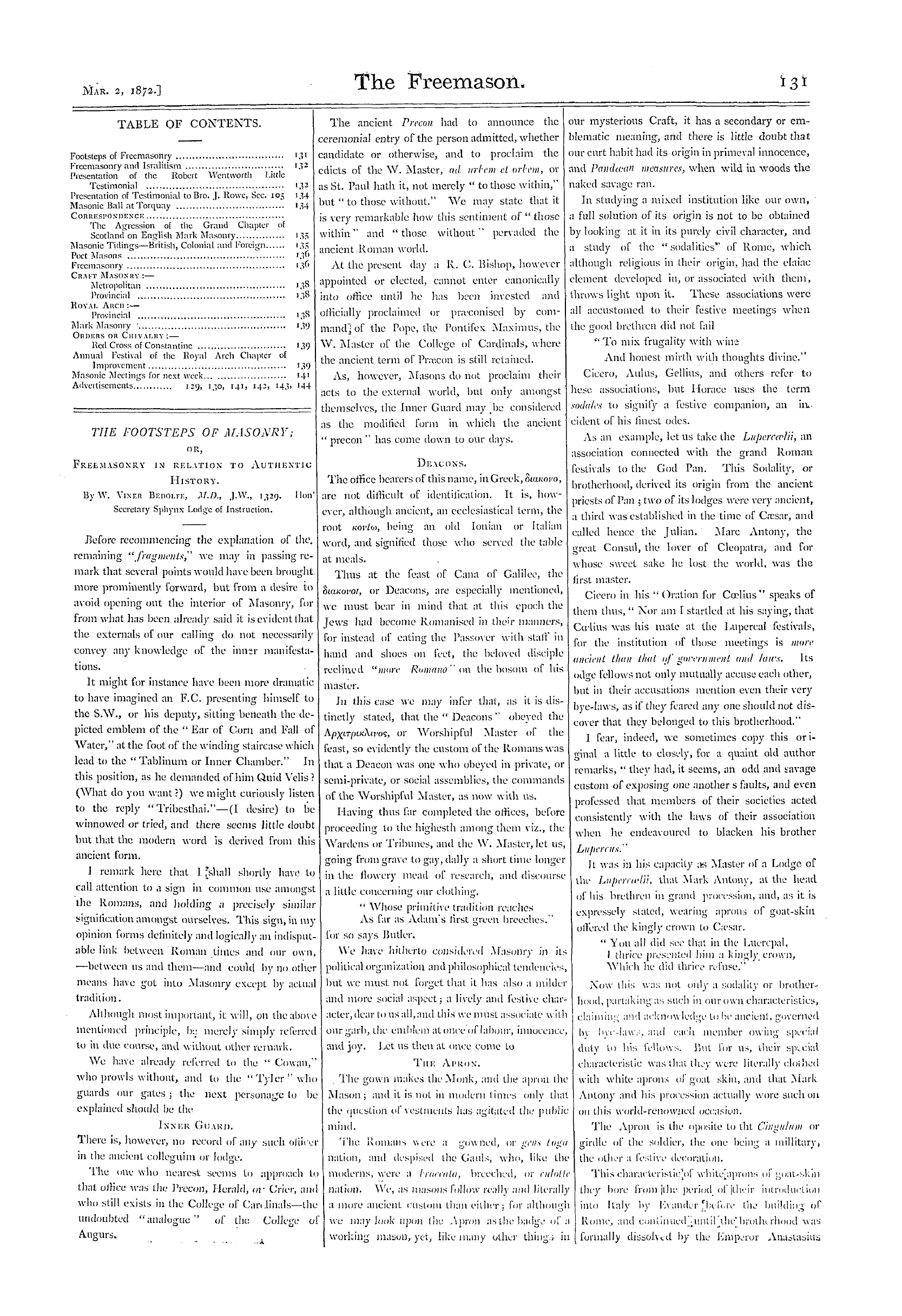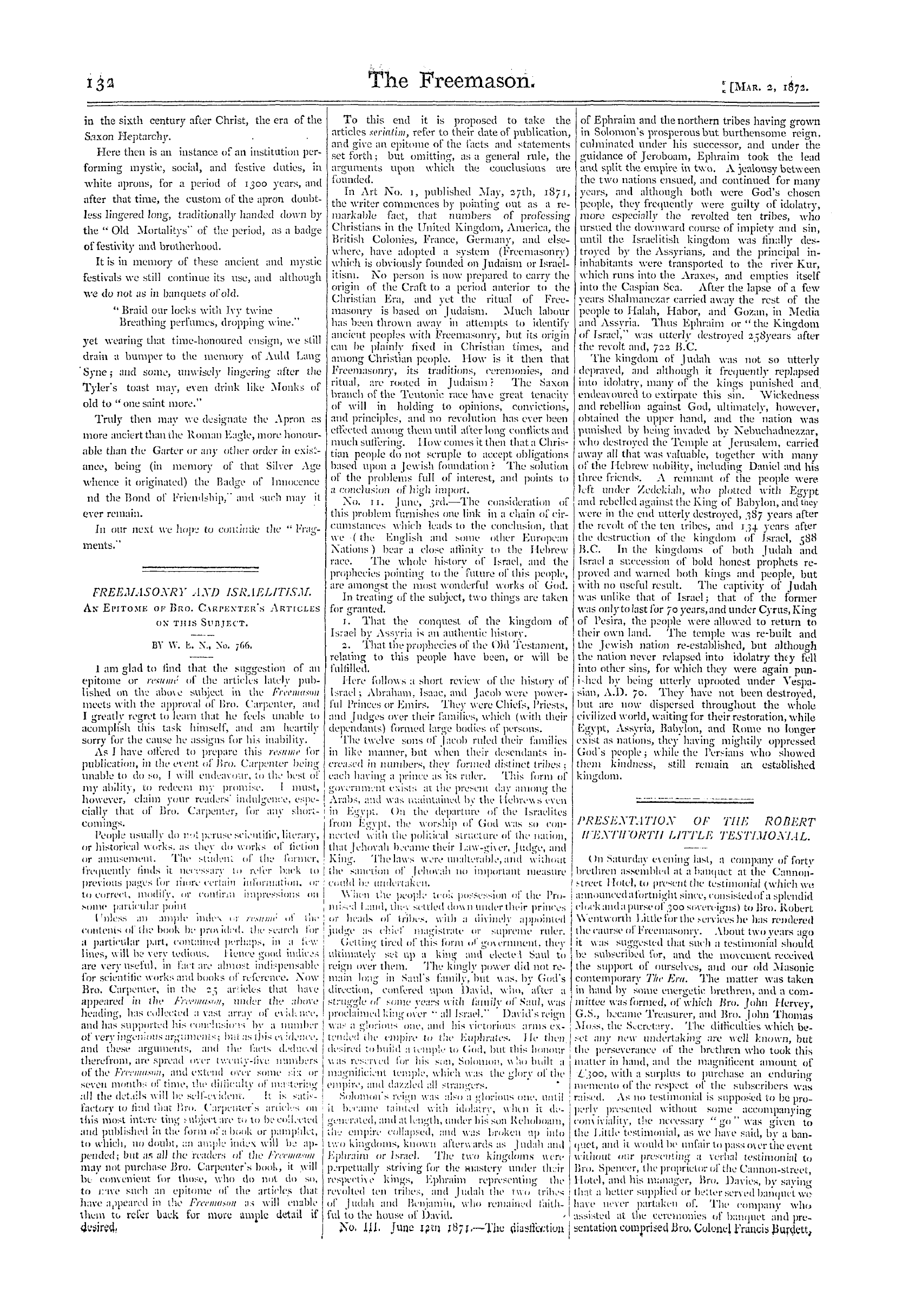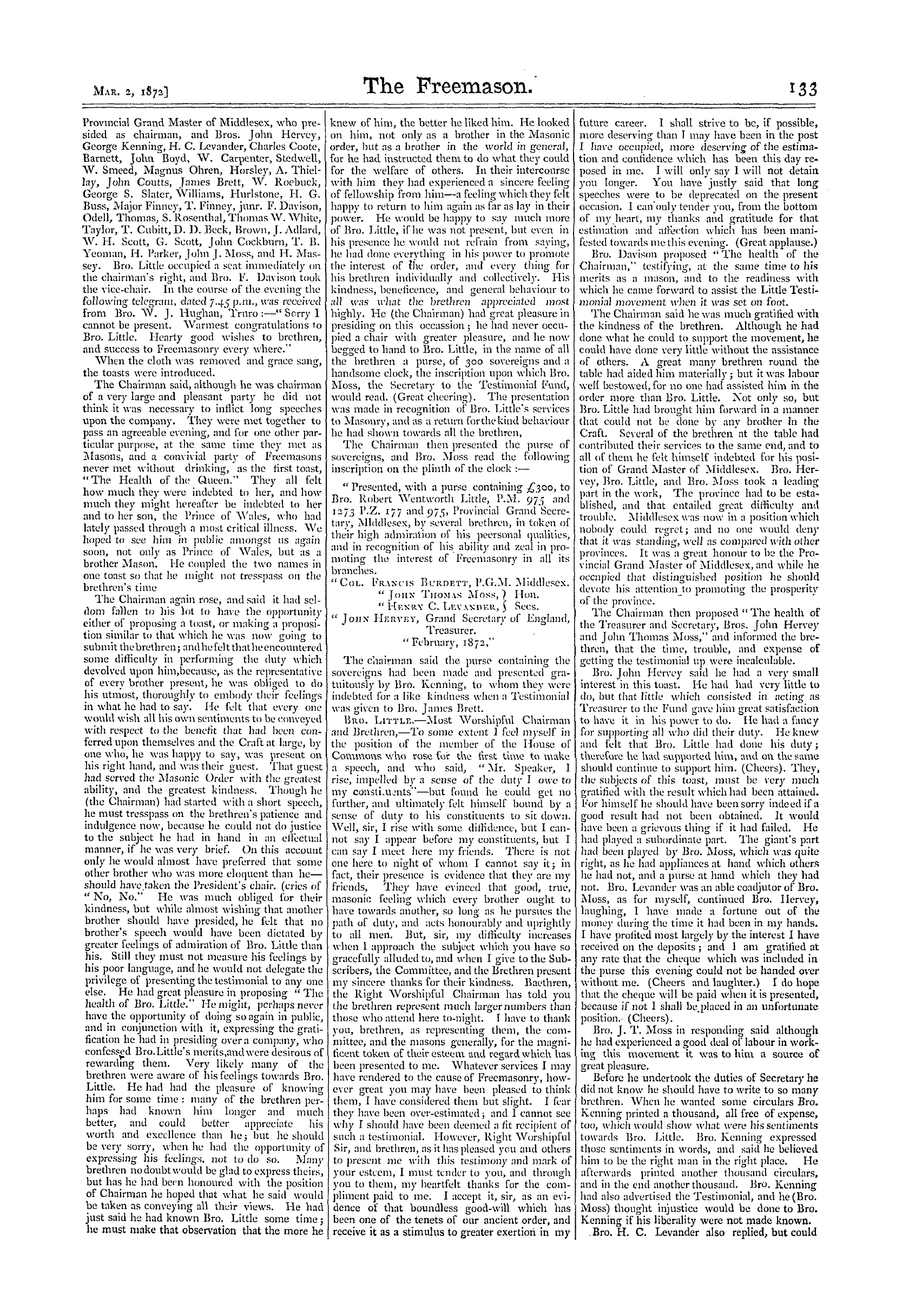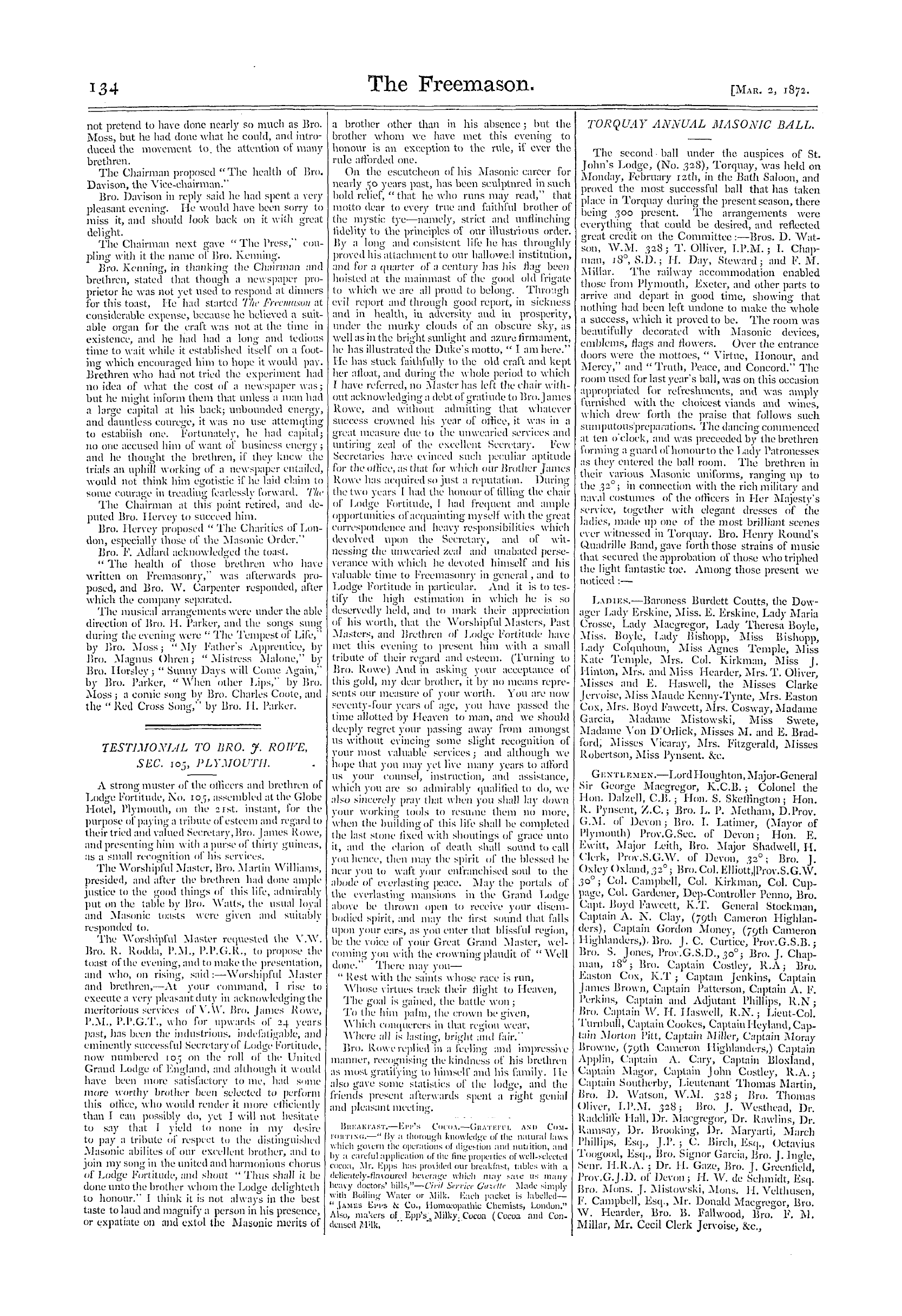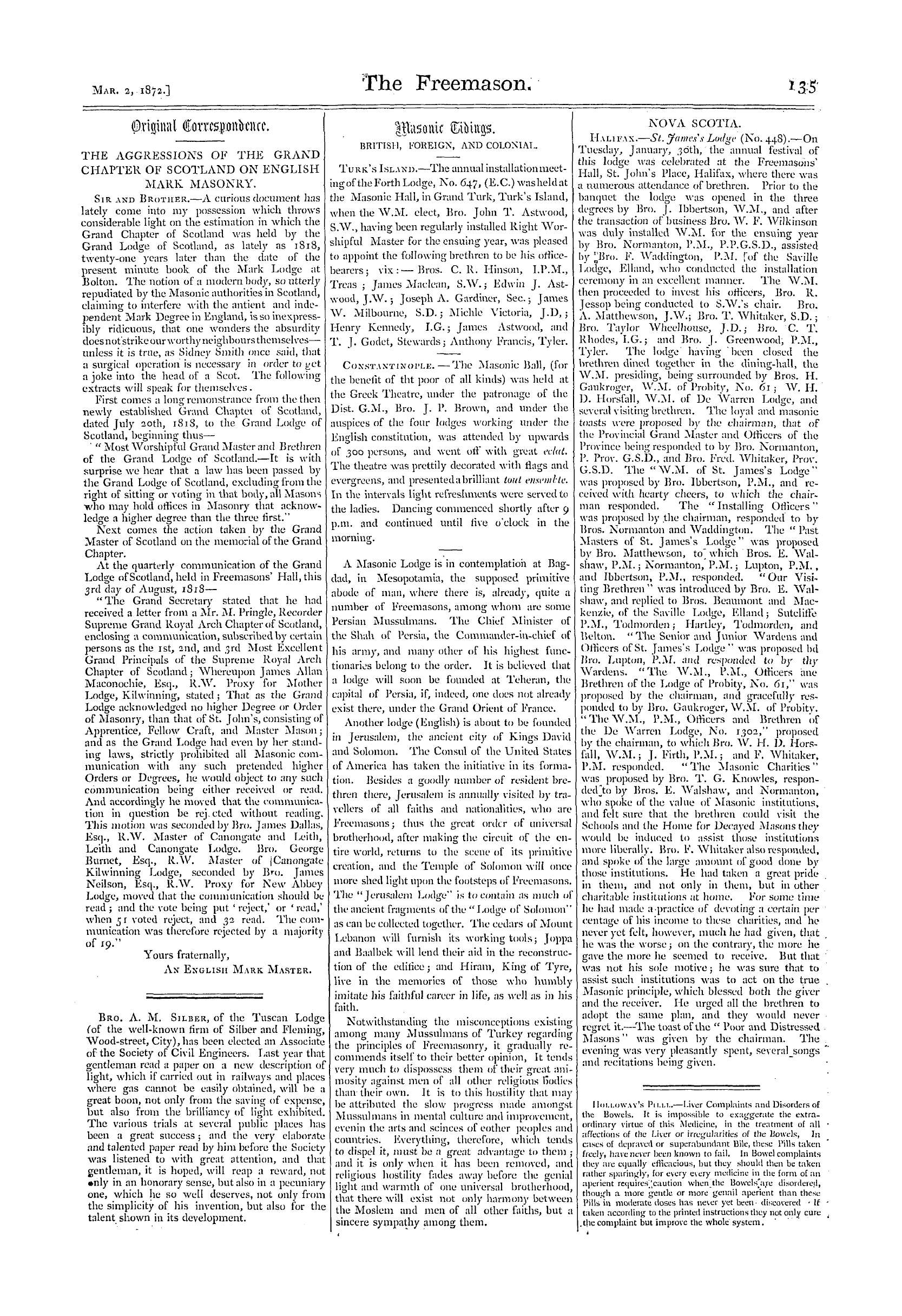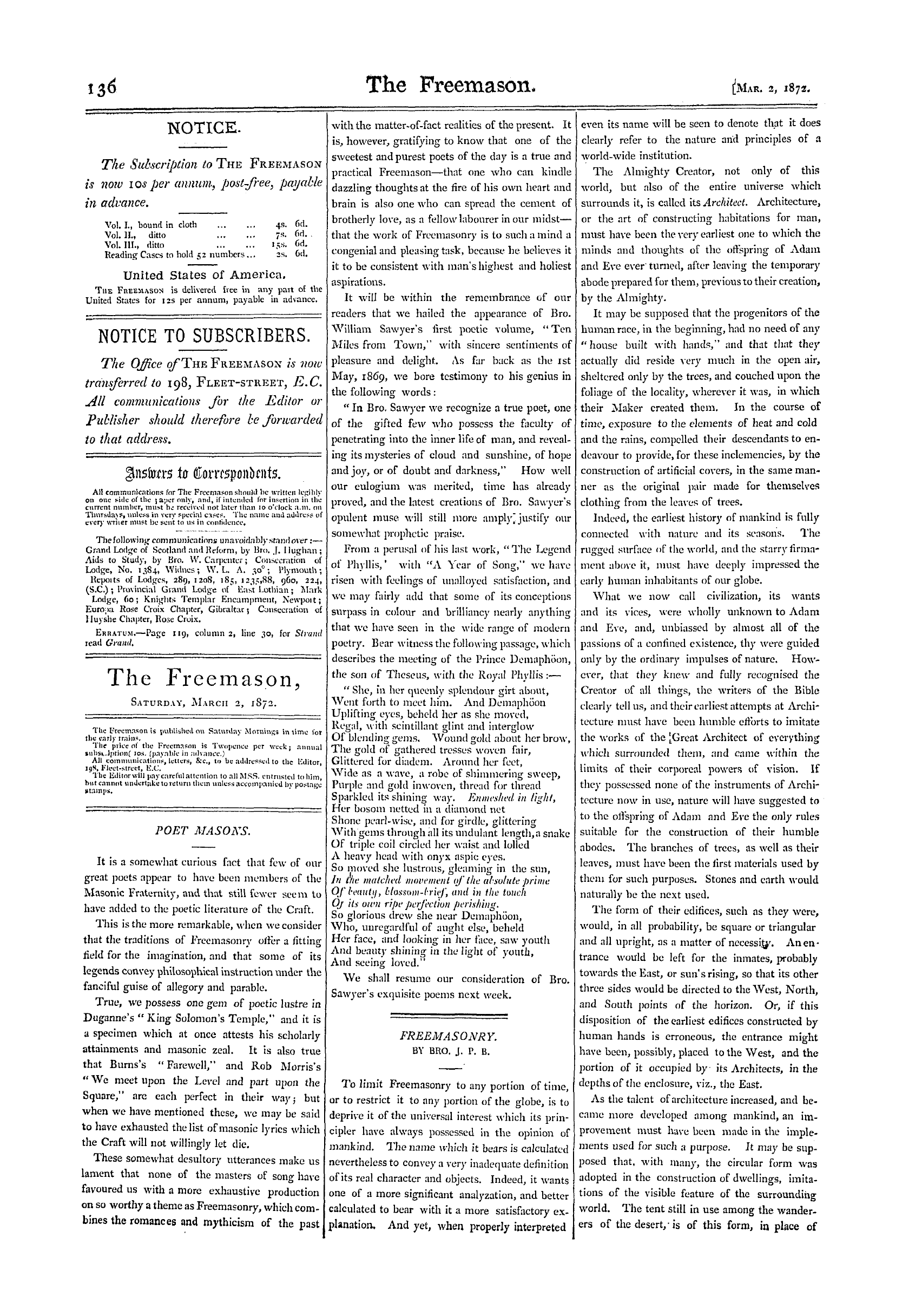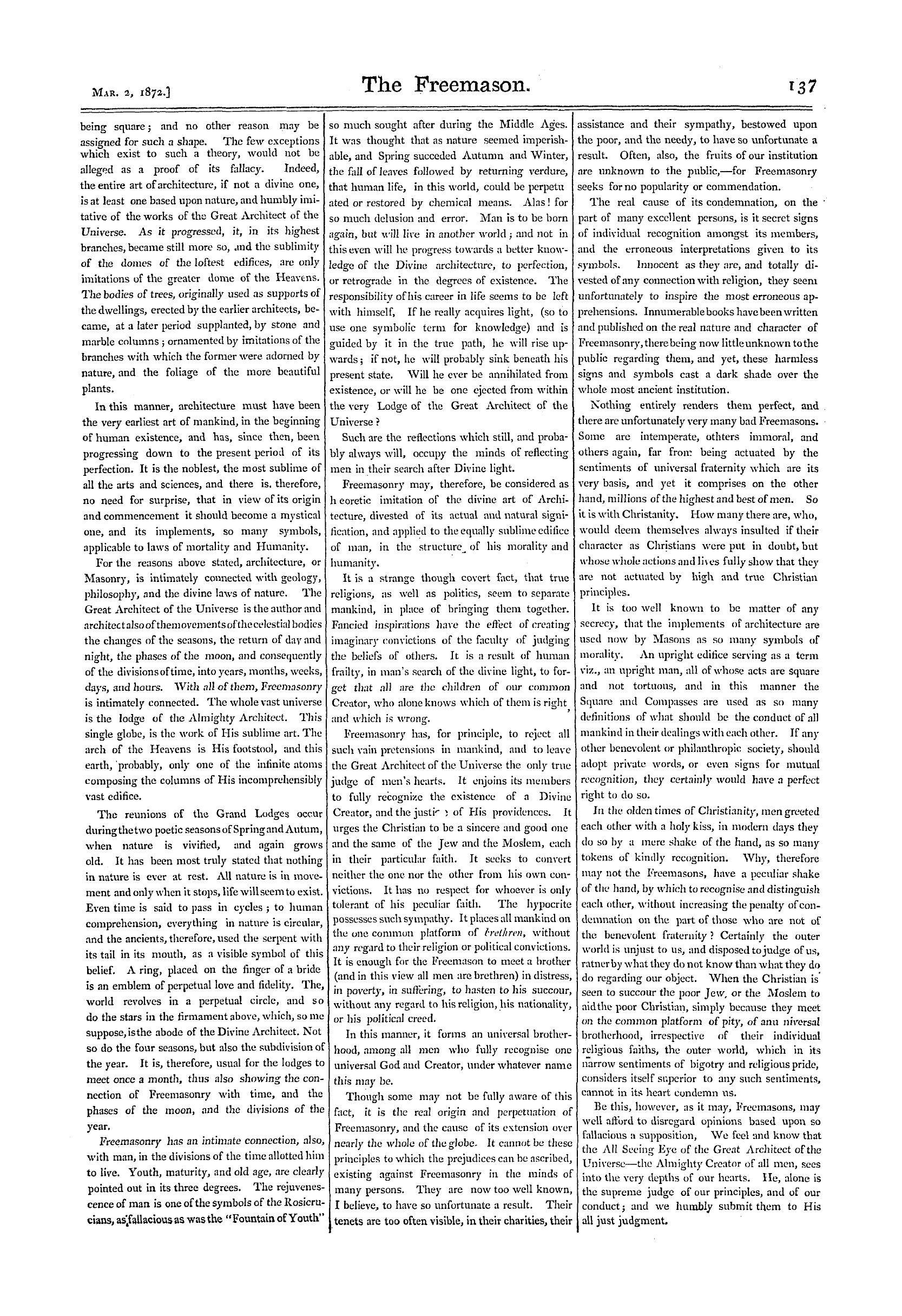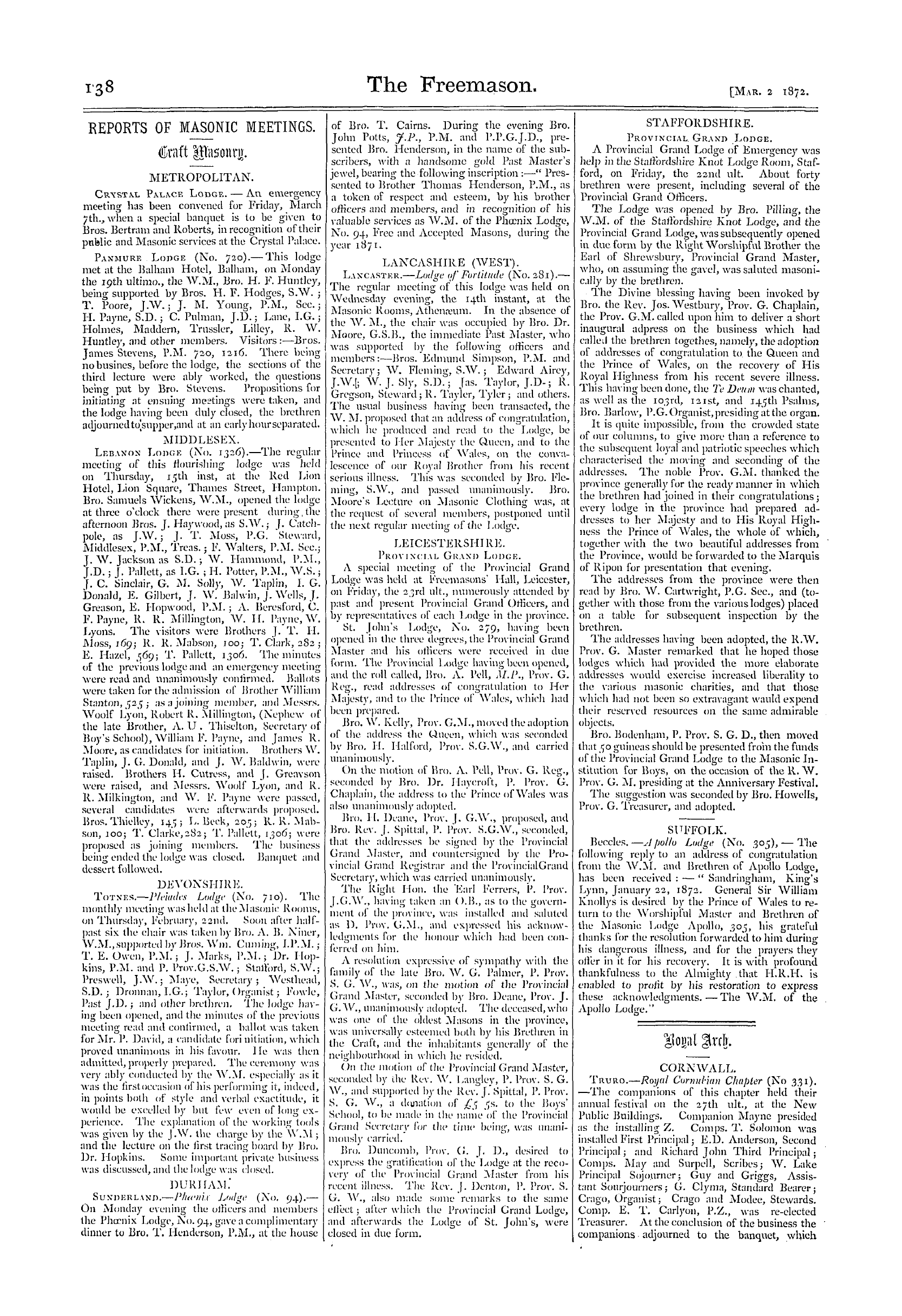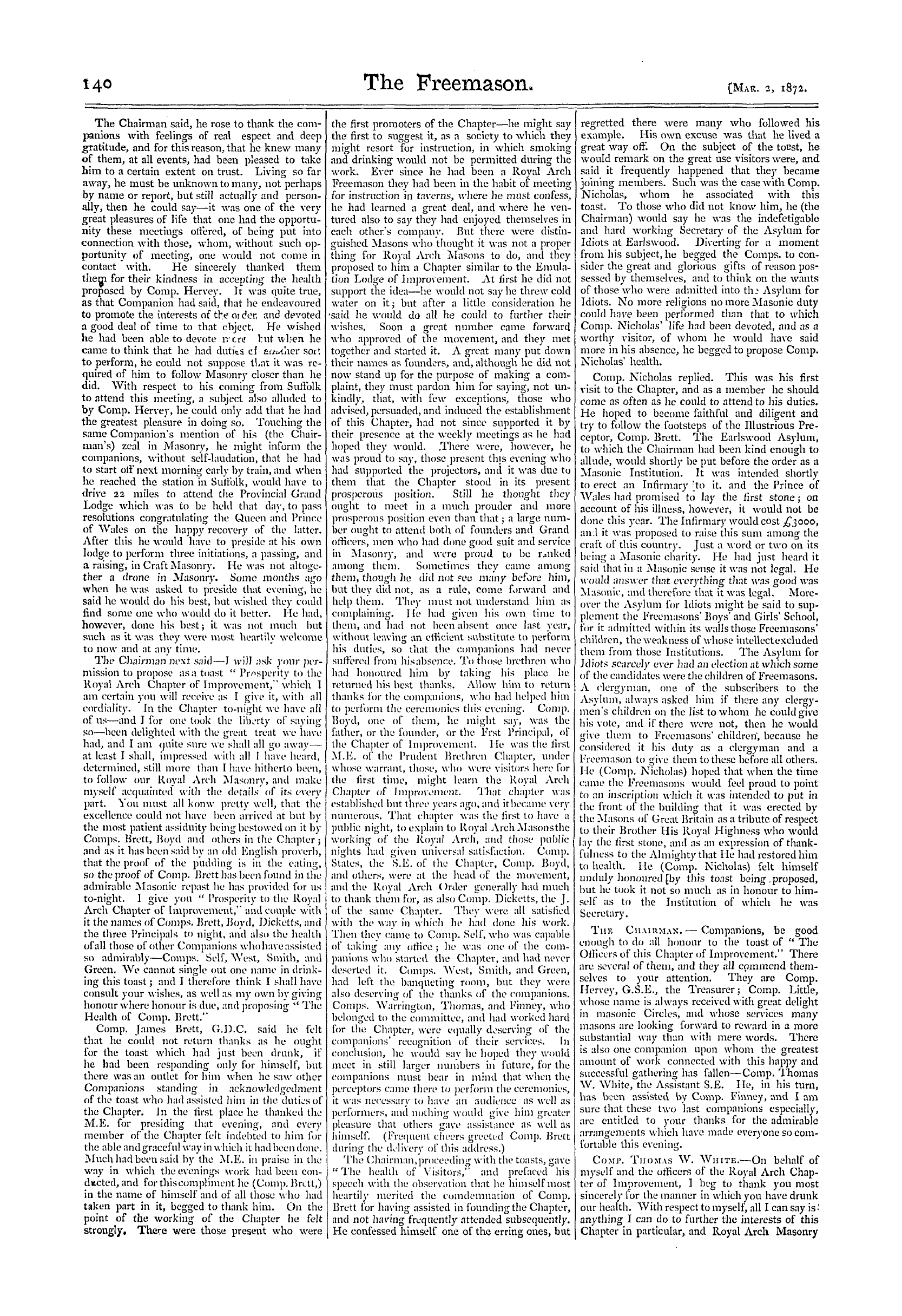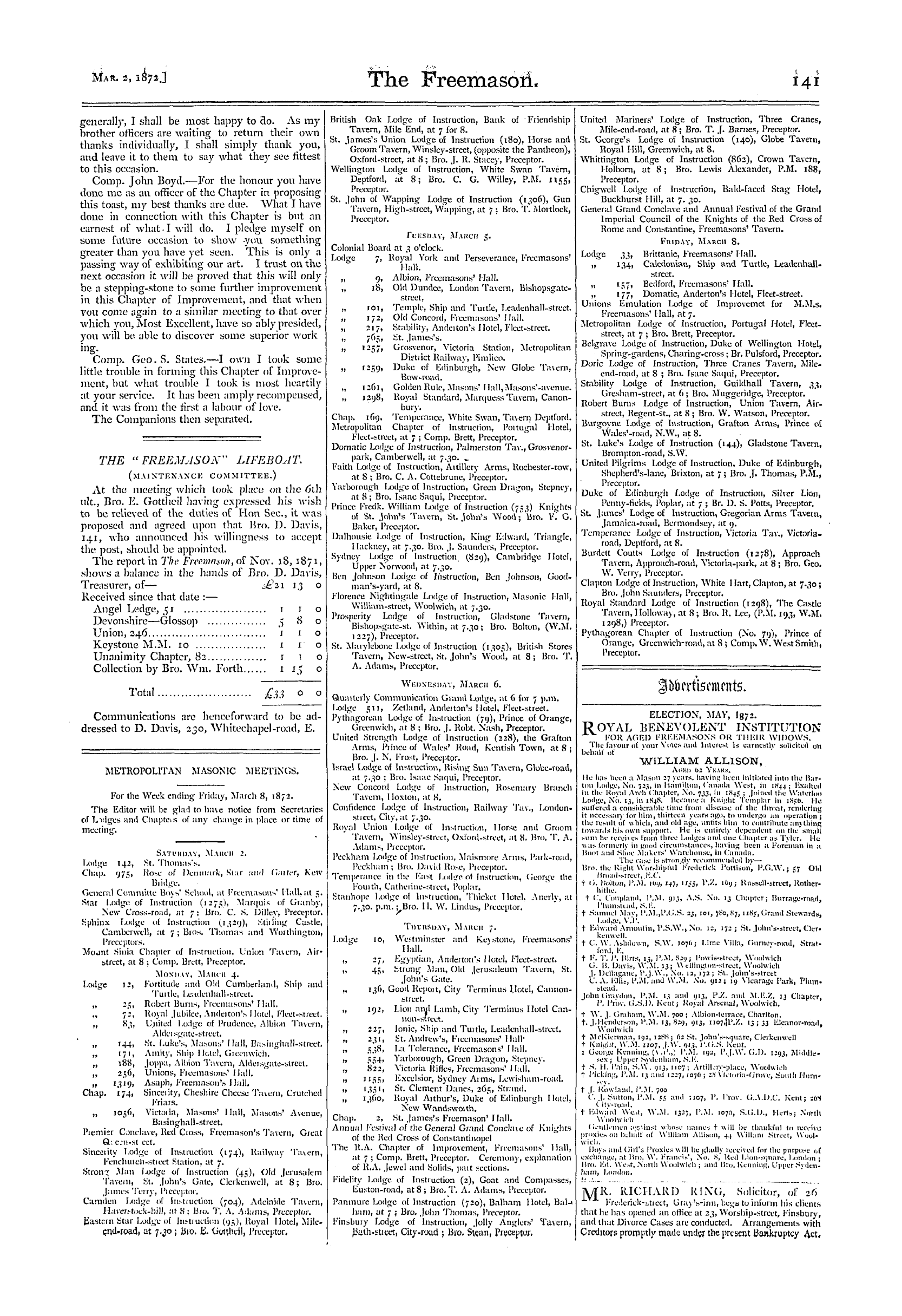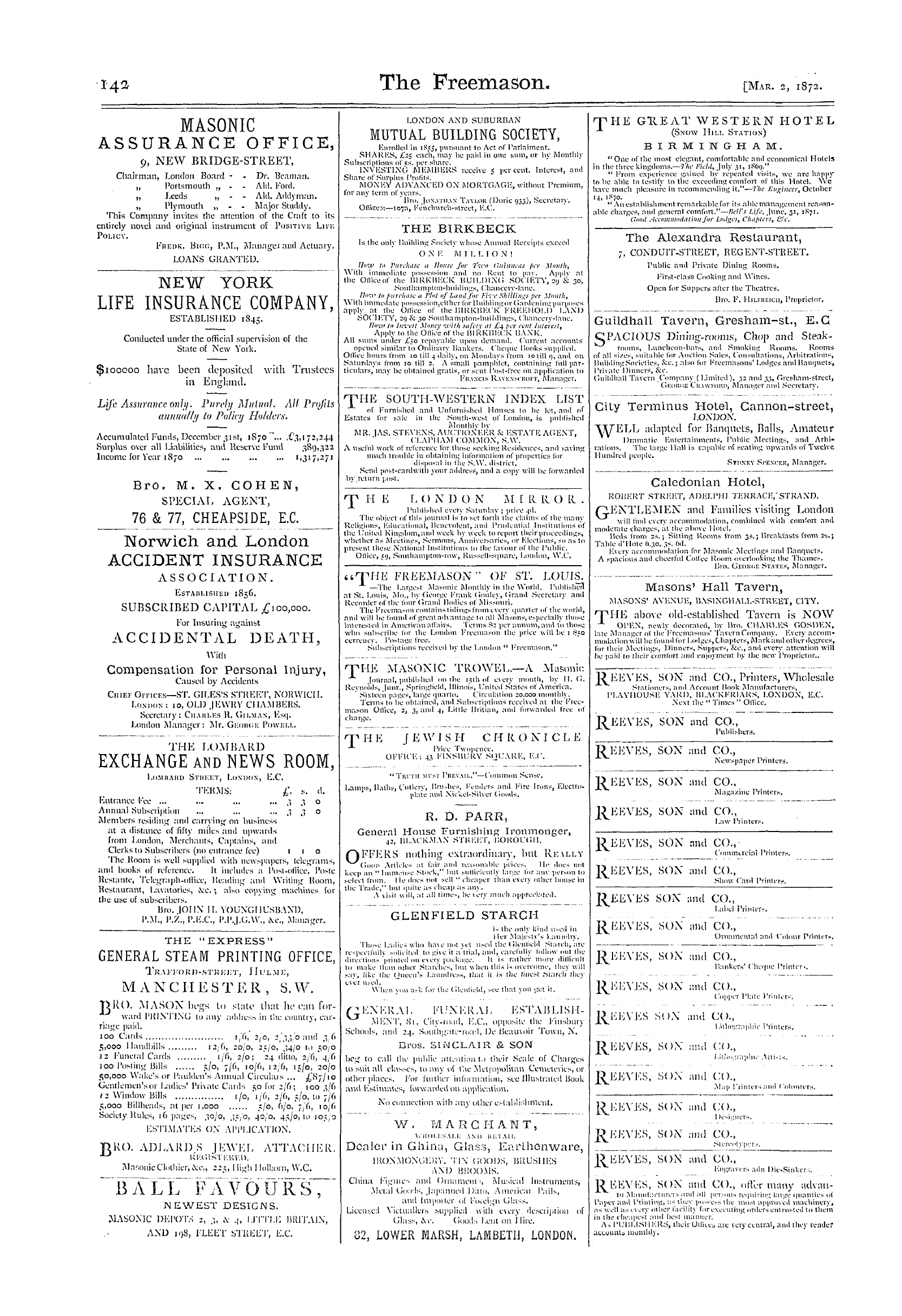-
Articles/Ads
Article Untitled Page 1 of 1 Article Untitled Page 1 of 1 Article Untitled Page 1 of 1 Article Untitled Page 1 of 1 Article POET MASONS. Page 1 of 1 Article POET MASONS. Page 1 of 1 Article FREEMASONRY. Page 1 of 2 Article FREEMASONRY. Page 1 of 2 →
Note: This text has been automatically extracted via Optical Character Recognition (OCR) software.
Ar00600
NOTICE . The Subscription to THE FREEMASON is notv IOS per annum , post-free , payable in advance . Vol . I ., bound in cloth 4 s . fid . Vol . II ., ditto 7 s . fid . Vol . III ., ditto i . vs . fid . Reading Cases to hold 52 numbers ... 2 s . Oil . United States of America . THE FREEMASON is delivered free in any part of the United States for 12 s per annum , payable in advance .
Ar00605
NOTICE TO SUBSCRIBERS . The Office of 'THE FREEMASON is now transferred to 198 , FLEET-STREET , E . C . All communications for the Editor or Publisher should therefore be forwarded to that address .
Ar00606
llitstecrs to tarrspnbciits . AH communications for The Freemason should be written legibly on one side of tile J aper only , and , if intended for insertion in the current number , must be received not later than 10 o'clock a . m . on Thursday , unless in very special cases . The name and address of every writer must be sent to us in confidence . Thefollowinjr communications unavoidably stand over : — Granil Lodge of Scotland and Reform , by Bro . J . I lugh . in ; Aids to Study , by Bro . W . Carpenter ; Consecration of Lodge , No . 13 S +, Widnes ; \ V . L . A . 30 ° ; Plymouth ; Repoits of Lodges , 289 , 1208 , 185 , la . ^ , 5 O 0 , 224 , ( S . C . ); Provincial Grand Lodge of Knst Lothian ; Mark Lodge , fio ; Knights Templar Encampment , Newpoit ; Euro ;> a Rose Croix Chapter , Gibraltar j Consecration of Iluyshe Chapter , Rose Croix . ERRATUM . —Page 119 , column 2 , line 30 , for Strand read Grand .
Ar00607
TheFreemason, SATURDAY , MARCH 2 , 1872 . The Freemason is published on Saturday Mornings in lime lor the early trains . The price ol' the Freemason is Twopence per week ; annual suhsi „) prinn ( IOS . ( payable in advance . ) All communication ' s , letters , & c , to be addressed to the Editor , J 9 S , Fleet-street , K . C . The Editor will pay careful attention toallMSS . entrusted to him , but cannot undertake to return them unless accompanied hv postage iitamps .
Poet Masons.
POET MASONS .
It is a somewhat curious fact that few of our great poets appear to have been members of the Masonic Fraternity , and that still fewer seem to have added to the poetic literature of the Craft .
This is the more remarkable , when we consider that the traditions of Freemasonry offer a fitting field for the imagination , and that some of its legends convey philosophical instruction under the
fanciful guise of allegory and parable . True , we possess one gem of poetic lustre in Duganne ' s " King Solomon ' s Temple , " and it is a specimen which at once attests his scholarl y
attainments and masonic zeal . It is also true that Burns ' s "Farewell , " and Rob Morris ' s " We meet upon the Level and part upon the Square , " are each perfect in their way ; but
when we have mentioned these , we may be said to have exhausted the list of masonic lyrics which the Craft will not willingly let die . These somewhat desultory utterances make us
lament that none of the masters of song have favoured us with a more exhaustive production on so worthy a theme as Freemasonry , which combines the romances and mythicism of the past
Poet Masons.
with the matter-of-fact realities of the present . It is , however , gratifying to know that one of the sweetest and purest poets of the day is a true and
practical Freemason—that one who can kindle dazzling thoughts at the fire of his own heart and brain is also one who can spread the cement of brotherly love , as a fellow labourer in our
midstthat the work of Freemasonry is to such a mind a congenial and pleasing task , because he believes it it to be consistent with man ' s highest and holiest aspirations . It will be within the remembrance of our
readers that we hailed the appearance of Bro . William Sawyer ' s first poetic volume , " Ten Miles from Town , " with sincere sentiments of pleasure and delight . As far back as the 1 st May , 186 9 , we bore testimony to his genius in
the following words : " In Bro . Sawyer we recognize a true poet , one of the gifted few who possess the faculty of penetrating into the inner life of man , and revealing its mysteries of cloud and sunshine , of hope
and joy , or of doubt and darkness , " How well our eulogium was merited , time has already proved , and the latest creations of Bro . Sawyer ' s opulent muse will still more ampl y " justify our somewhat prophetic praise .
From a perusal of his last work , " The Legend of Phyllis , ' with "A Year of Song , " we have risen with feelings of unalloyed satisfaction , and we may fairly add that some of its conceptions surpass in colour and brilliancy nearly anything
that we have seen in the wide range of modern poetry . Bear witness the following passage , which describes the meeting of the Prince Demaphoon , the son of Theseus , with the Royal Phyllis : — " She , in her queenly splendour girt about ,
Went forth to meet him . And Demaphoon Uplifting eyes , beheld her as she moved , Regal , with scintillant glint and interglow Of blending gems . Wound gold about her brow , The gold of gathered tresses woven fair ,
Glittered for diadem . Around her feet , Wide as a wave , a robe of shimmering sweep , Purple and gold inwoven , thread for thread Sparkled its shining way . Enmeshed in light , Her bosom netted in a diamond net
Shone pearl-wise , and for girdle , glittering With gems through all its undulant length , a snake Of triple coil circled her waist and lolled A heavy head with onyx aspic eyes . So moved she lustrousleaming in the sun
, g , ' o a — ----, In the matched movement of the absolute prime Ofbeauti / , blossom-brief , and in the touch Oj its own ripe perfection perishing . So glorious drew she near Demaphoon ,
Who , uuregardful of aught else , beheld Her face , and looking in her face , saw youth And beauty shining in the li ght of youth , And seeing loved . " We shall resume our consideration of Bro . Sawyer ' s exquisite poems next week .
Freemasonry.
FREEMASONRY .
BY BRO . J . P . B . To limit Freemasonry to any portion of time , or to restrict it to any portion of the globe , is to deprive it of the universal interest which its
principler have always possessed in the opinion of mankind . The name which it bears is calculated nevertheless to convey a very inadequate definition
of its real character and objects . Indeed , it wants one of a more significant analyzation , and better calculated to bear with it a more satisfactory explanation . And yet , when properly interpreted
Freemasonry.
even its name will be seen to denote that it does clearly refer to the nature and princip les of a world-wide institution . The Almighty Creator , not only of this
world , but also of the entire universe which surrounds it , is called its Architect . Architecture , or the art of constructing habitations for man , must have been the very earliest one to which the
minds and thoughts of the offspring of Adam and Eve ever turned , after leaving the temporary abode prepared for them , previous to their creation , by the Almighty .
It may be supposed that the progenitors of the human race , in the beginning , had no need of any "house built with hands , " and that that they actually did reside Aery much in the open air ,
sheltered only by the trees , and couched upon the foliage of the locality , wherever it was , in which their Maker created them . In the course of time , exposure to the elements of heat and cold
and the rains , compelled their descendants to endeavour to provide , for these inclemencies , by the construction of artificial covers , in the same manner as the original pair made for themselves
clothing from the leaves of trees . Indeed , the earliest history of mankind is fully connected with nature and its seasons . The rugged surface of the world , and the starry
firmament above it , must have deeply impressed the early human inhabitants of our globe . What we now call civilization , its wants and its vices , were wholly unknown to Adam
and Eve , and , unbiassed by almost all of the passions of a confined existence , thy were guided only by the ordinary impulses of nature . However , that they knew and fully recognised the
Creator of all things , the writers of the Bible clearl y tell us , and their earliest attempts at Architecture must have been humble efforts to imitate the works of the J . Great Architect of everything
which surrounded them , and came within the limits of their corporeal powers of vision . If they possessed none of the instruments of Architecture now in use , nature will have suggested to
to the offspring of Adam and Eve the only rules suitable for the construction of their humble abodes . The branches of trees , as well as their leaves , must have been the first materials used b y
them for such purposes . Stones and earth would naturally be the next used . The form of their edifices , such as they were , would , in all probability , be square or triangular
and all upright , as a matter of necessity . An en trance would be left for the inmates , probably towards the East , or sun ' s rising , so that its other three sides would be directed to the West , North ,
and South points of the horizon . Or , if this disposition of the earliest edifices constructed b y human hands is erroneous , the entrance mi ght have been , possibly , placed to the West , and the
portion of it occupied by its Architects , in the depths of the enclosure , viz ., the East . As the talent of architecture increased , and became more developed among mankind , an
improvement must have been made in the implements used for such a purpose . It may be supposed that , with many , the circular form was
adopted in the construction of dwellings , imitations of the visible feature of the surrounding world . The tent still in use among the wanderers of the desert , is of this form , in place of
Note: This text has been automatically extracted via Optical Character Recognition (OCR) software.
Ar00600
NOTICE . The Subscription to THE FREEMASON is notv IOS per annum , post-free , payable in advance . Vol . I ., bound in cloth 4 s . fid . Vol . II ., ditto 7 s . fid . Vol . III ., ditto i . vs . fid . Reading Cases to hold 52 numbers ... 2 s . Oil . United States of America . THE FREEMASON is delivered free in any part of the United States for 12 s per annum , payable in advance .
Ar00605
NOTICE TO SUBSCRIBERS . The Office of 'THE FREEMASON is now transferred to 198 , FLEET-STREET , E . C . All communications for the Editor or Publisher should therefore be forwarded to that address .
Ar00606
llitstecrs to tarrspnbciits . AH communications for The Freemason should be written legibly on one side of tile J aper only , and , if intended for insertion in the current number , must be received not later than 10 o'clock a . m . on Thursday , unless in very special cases . The name and address of every writer must be sent to us in confidence . Thefollowinjr communications unavoidably stand over : — Granil Lodge of Scotland and Reform , by Bro . J . I lugh . in ; Aids to Study , by Bro . W . Carpenter ; Consecration of Lodge , No . 13 S +, Widnes ; \ V . L . A . 30 ° ; Plymouth ; Repoits of Lodges , 289 , 1208 , 185 , la . ^ , 5 O 0 , 224 , ( S . C . ); Provincial Grand Lodge of Knst Lothian ; Mark Lodge , fio ; Knights Templar Encampment , Newpoit ; Euro ;> a Rose Croix Chapter , Gibraltar j Consecration of Iluyshe Chapter , Rose Croix . ERRATUM . —Page 119 , column 2 , line 30 , for Strand read Grand .
Ar00607
TheFreemason, SATURDAY , MARCH 2 , 1872 . The Freemason is published on Saturday Mornings in lime lor the early trains . The price ol' the Freemason is Twopence per week ; annual suhsi „) prinn ( IOS . ( payable in advance . ) All communication ' s , letters , & c , to be addressed to the Editor , J 9 S , Fleet-street , K . C . The Editor will pay careful attention toallMSS . entrusted to him , but cannot undertake to return them unless accompanied hv postage iitamps .
Poet Masons.
POET MASONS .
It is a somewhat curious fact that few of our great poets appear to have been members of the Masonic Fraternity , and that still fewer seem to have added to the poetic literature of the Craft .
This is the more remarkable , when we consider that the traditions of Freemasonry offer a fitting field for the imagination , and that some of its legends convey philosophical instruction under the
fanciful guise of allegory and parable . True , we possess one gem of poetic lustre in Duganne ' s " King Solomon ' s Temple , " and it is a specimen which at once attests his scholarl y
attainments and masonic zeal . It is also true that Burns ' s "Farewell , " and Rob Morris ' s " We meet upon the Level and part upon the Square , " are each perfect in their way ; but
when we have mentioned these , we may be said to have exhausted the list of masonic lyrics which the Craft will not willingly let die . These somewhat desultory utterances make us
lament that none of the masters of song have favoured us with a more exhaustive production on so worthy a theme as Freemasonry , which combines the romances and mythicism of the past
Poet Masons.
with the matter-of-fact realities of the present . It is , however , gratifying to know that one of the sweetest and purest poets of the day is a true and
practical Freemason—that one who can kindle dazzling thoughts at the fire of his own heart and brain is also one who can spread the cement of brotherly love , as a fellow labourer in our
midstthat the work of Freemasonry is to such a mind a congenial and pleasing task , because he believes it it to be consistent with man ' s highest and holiest aspirations . It will be within the remembrance of our
readers that we hailed the appearance of Bro . William Sawyer ' s first poetic volume , " Ten Miles from Town , " with sincere sentiments of pleasure and delight . As far back as the 1 st May , 186 9 , we bore testimony to his genius in
the following words : " In Bro . Sawyer we recognize a true poet , one of the gifted few who possess the faculty of penetrating into the inner life of man , and revealing its mysteries of cloud and sunshine , of hope
and joy , or of doubt and darkness , " How well our eulogium was merited , time has already proved , and the latest creations of Bro . Sawyer ' s opulent muse will still more ampl y " justify our somewhat prophetic praise .
From a perusal of his last work , " The Legend of Phyllis , ' with "A Year of Song , " we have risen with feelings of unalloyed satisfaction , and we may fairly add that some of its conceptions surpass in colour and brilliancy nearly anything
that we have seen in the wide range of modern poetry . Bear witness the following passage , which describes the meeting of the Prince Demaphoon , the son of Theseus , with the Royal Phyllis : — " She , in her queenly splendour girt about ,
Went forth to meet him . And Demaphoon Uplifting eyes , beheld her as she moved , Regal , with scintillant glint and interglow Of blending gems . Wound gold about her brow , The gold of gathered tresses woven fair ,
Glittered for diadem . Around her feet , Wide as a wave , a robe of shimmering sweep , Purple and gold inwoven , thread for thread Sparkled its shining way . Enmeshed in light , Her bosom netted in a diamond net
Shone pearl-wise , and for girdle , glittering With gems through all its undulant length , a snake Of triple coil circled her waist and lolled A heavy head with onyx aspic eyes . So moved she lustrousleaming in the sun
, g , ' o a — ----, In the matched movement of the absolute prime Ofbeauti / , blossom-brief , and in the touch Oj its own ripe perfection perishing . So glorious drew she near Demaphoon ,
Who , uuregardful of aught else , beheld Her face , and looking in her face , saw youth And beauty shining in the li ght of youth , And seeing loved . " We shall resume our consideration of Bro . Sawyer ' s exquisite poems next week .
Freemasonry.
FREEMASONRY .
BY BRO . J . P . B . To limit Freemasonry to any portion of time , or to restrict it to any portion of the globe , is to deprive it of the universal interest which its
principler have always possessed in the opinion of mankind . The name which it bears is calculated nevertheless to convey a very inadequate definition
of its real character and objects . Indeed , it wants one of a more significant analyzation , and better calculated to bear with it a more satisfactory explanation . And yet , when properly interpreted
Freemasonry.
even its name will be seen to denote that it does clearly refer to the nature and princip les of a world-wide institution . The Almighty Creator , not only of this
world , but also of the entire universe which surrounds it , is called its Architect . Architecture , or the art of constructing habitations for man , must have been the very earliest one to which the
minds and thoughts of the offspring of Adam and Eve ever turned , after leaving the temporary abode prepared for them , previous to their creation , by the Almighty .
It may be supposed that the progenitors of the human race , in the beginning , had no need of any "house built with hands , " and that that they actually did reside Aery much in the open air ,
sheltered only by the trees , and couched upon the foliage of the locality , wherever it was , in which their Maker created them . In the course of time , exposure to the elements of heat and cold
and the rains , compelled their descendants to endeavour to provide , for these inclemencies , by the construction of artificial covers , in the same manner as the original pair made for themselves
clothing from the leaves of trees . Indeed , the earliest history of mankind is fully connected with nature and its seasons . The rugged surface of the world , and the starry
firmament above it , must have deeply impressed the early human inhabitants of our globe . What we now call civilization , its wants and its vices , were wholly unknown to Adam
and Eve , and , unbiassed by almost all of the passions of a confined existence , thy were guided only by the ordinary impulses of nature . However , that they knew and fully recognised the
Creator of all things , the writers of the Bible clearl y tell us , and their earliest attempts at Architecture must have been humble efforts to imitate the works of the J . Great Architect of everything
which surrounded them , and came within the limits of their corporeal powers of vision . If they possessed none of the instruments of Architecture now in use , nature will have suggested to
to the offspring of Adam and Eve the only rules suitable for the construction of their humble abodes . The branches of trees , as well as their leaves , must have been the first materials used b y
them for such purposes . Stones and earth would naturally be the next used . The form of their edifices , such as they were , would , in all probability , be square or triangular
and all upright , as a matter of necessity . An en trance would be left for the inmates , probably towards the East , or sun ' s rising , so that its other three sides would be directed to the West , North ,
and South points of the horizon . Or , if this disposition of the earliest edifices constructed b y human hands is erroneous , the entrance mi ght have been , possibly , placed to the West , and the
portion of it occupied by its Architects , in the depths of the enclosure , viz ., the East . As the talent of architecture increased , and became more developed among mankind , an
improvement must have been made in the implements used for such a purpose . It may be supposed that , with many , the circular form was
adopted in the construction of dwellings , imitations of the visible feature of the surrounding world . The tent still in use among the wanderers of the desert , is of this form , in place of
